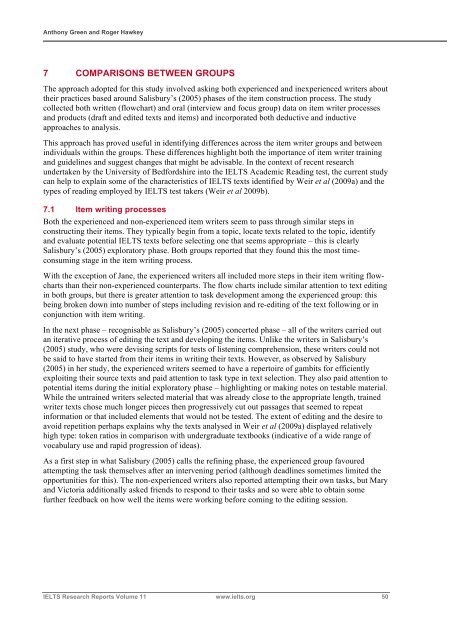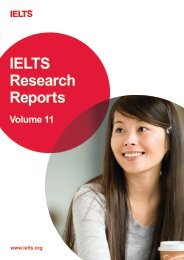An investigation of the process of writing IELTS Academic Reading ...
An investigation of the process of writing IELTS Academic Reading ...
An investigation of the process of writing IELTS Academic Reading ...
Create successful ePaper yourself
Turn your PDF publications into a flip-book with our unique Google optimized e-Paper software.
<strong>An</strong>thony Green and Roger Hawkey<br />
7 COMPARISONS BETWEEN GROUPS<br />
The approach adopted for this study involved asking both experienced and inexperienced writers about<br />
<strong>the</strong>ir practices based around Salisbury’s (2005) phases <strong>of</strong> <strong>the</strong> item construction <strong>process</strong>. The study<br />
collected both written (flowchart) and oral (interview and focus group) data on item writer <strong>process</strong>es<br />
and products (draft and edited texts and items) and incorporated both deductive and inductive<br />
approaches to analysis.<br />
This approach has proved useful in identifying differences across <strong>the</strong> item writer groups and between<br />
individuals within <strong>the</strong> groups. These differences highlight both <strong>the</strong> importance <strong>of</strong> item writer training<br />
and guidelines and suggest changes that might be advisable. In <strong>the</strong> context <strong>of</strong> recent research<br />
undertaken by <strong>the</strong> University <strong>of</strong> Bedfordshire into <strong>the</strong> <strong>IELTS</strong> <strong>Academic</strong> <strong>Reading</strong> test, <strong>the</strong> current study<br />
can help to explain some <strong>of</strong> <strong>the</strong> characteristics <strong>of</strong> <strong>IELTS</strong> texts identified by Weir et al (2009a) and <strong>the</strong><br />
types <strong>of</strong> reading employed by <strong>IELTS</strong> test takers (Weir et al 2009b).<br />
7.1 Item <strong>writing</strong> <strong>process</strong>es<br />
Both <strong>the</strong> experienced and non-experienced item writers seem to pass through similar steps in<br />
constructing <strong>the</strong>ir items. They typically begin from a topic, locate texts related to <strong>the</strong> topic, identify<br />
and evaluate potential <strong>IELTS</strong> texts before selecting one that seems appropriate – this is clearly<br />
Salisbury’s (2005) exploratory phase. Both groups reported that <strong>the</strong>y found this <strong>the</strong> most timeconsuming<br />
stage in <strong>the</strong> item <strong>writing</strong> <strong>process</strong>.<br />
With <strong>the</strong> exception <strong>of</strong> Jane, <strong>the</strong> experienced writers all included more steps in <strong>the</strong>ir item <strong>writing</strong> flowcharts<br />
than <strong>the</strong>ir non-experienced counterparts. The flow charts include similar attention to text editing<br />
in both groups, but <strong>the</strong>re is greater attention to task development among <strong>the</strong> experienced group: this<br />
being broken down into number <strong>of</strong> steps including revision and re-editing <strong>of</strong> <strong>the</strong> text following or in<br />
conjunction with item <strong>writing</strong>.<br />
In <strong>the</strong> next phase – recognisable as Salisbury’s (2005) concerted phase – all <strong>of</strong> <strong>the</strong> writers carried out<br />
an iterative <strong>process</strong> <strong>of</strong> editing <strong>the</strong> text and developing <strong>the</strong> items. Unlike <strong>the</strong> writers in Salisbury’s<br />
(2005) study, who were devising scripts for tests <strong>of</strong> listening comprehension, <strong>the</strong>se writers could not<br />
be said to have started from <strong>the</strong>ir items in <strong>writing</strong> <strong>the</strong>ir texts. However, as observed by Salisbury<br />
(2005) in her study, <strong>the</strong> experienced writers seemed to have a repertoire <strong>of</strong> gambits for efficiently<br />
exploiting <strong>the</strong>ir source texts and paid attention to task type in text selection. They also paid attention to<br />
potential items during <strong>the</strong> initial exploratory phase – highlighting or making notes on testable material.<br />
While <strong>the</strong> untrained writers selected material that was already close to <strong>the</strong> appropriate length, trained<br />
writer texts chose much longer pieces <strong>the</strong>n progressively cut out passages that seemed to repeat<br />
information or that included elements that would not be tested. The extent <strong>of</strong> editing and <strong>the</strong> desire to<br />
avoid repetition perhaps explains why <strong>the</strong> texts analysed in Weir et al (2009a) displayed relatively<br />
high type: token ratios in comparison with undergraduate textbooks (indicative <strong>of</strong> a wide range <strong>of</strong><br />
vocabulary use and rapid progression <strong>of</strong> ideas).<br />
As a first step in what Salisbury (2005) calls <strong>the</strong> refining phase, <strong>the</strong> experienced group favoured<br />
attempting <strong>the</strong> task <strong>the</strong>mselves after an intervening period (although deadlines sometimes limited <strong>the</strong><br />
opportunities for this). The non-experienced writers also reported attempting <strong>the</strong>ir own tasks, but Mary<br />
and Victoria additionally asked friends to respond to <strong>the</strong>ir tasks and so were able to obtain some<br />
fur<strong>the</strong>r feedback on how well <strong>the</strong> items were working before coming to <strong>the</strong> editing session.<br />
<strong>IELTS</strong> Research Reports Volume 11 www.ielts.org 50

















